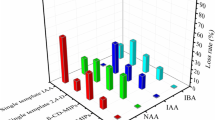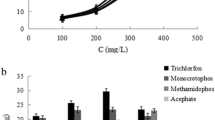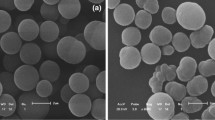Abstract
The molecularly imprinted polymers (MIPs) were synthesised and the influence of the type of porogen, the nature of sample solvent, and the binding capacity of material were tested by high-performance liquid chromatography (HPLC). Umbelliferone was used as the template for imprint formation. Methacrylic acid was used as the monomer and acetonitrile, ethanol, and chloroform as porogen. Non-imprinted polymers (NIPs) were prepared by the same procedure. The highest value of the specific binding capacity (269 μg of umbelliferone per 100 mg of polymer) was obtained for polymers prepared in chloroform as porogen and methanol/water (φ r = 1: 1) as the sample solvent. The group-selective MIP was used as sorbent for the SPE pre-treatment of umbelliferone from plant extracts prior to HPLC analysis. Analysis of the spiked samples showed good recoveries (> 77 %). The limit of detection, limit of determination, and repeatability of the method were also calculated.
Similar content being viewed by others
References
Blahová, E., & Brandšteterová, E. (2004). Approaches in sample handling before HPLC analysis of complex matrices. Chemical Papers, 58, 362–373.
Ciésla, Ł., & Waksmundzka-Hajnos, M. (2009). Two-dimensional thin-layer chromatography in the analysis of secondary plant metabolites. Journal of Chromatography A, 1216, 1035–1052. DOI: 10.1016/j.chroma.2008.12.057.
Chen, D., Wang, J., Jiang, Y., Zhou, T., Fan, G., & Wu, Y. (2009). Separation and determination of coumarins in Fructus cnidii extracts by pressurized capillary electrochromatography using a packed column with a monolithic outlet frit. Journal of Pharmaceutical and Biomedical Analysis, 50, 695–702. DOI: 10.1016/j.jpba.2009.05.026.
Dawa, Z., Zhou, Y., Bai, Y., Gesang, S., Bai, B., & Ding, L. (2008). Development of an HPLC-DAD-ESI-MSn method for quantitative analysis of Saussurea tridactyla. Journal of Pharmaceutical and Biomedical Analysis, 48, 1076–1081. DOI: 10.1016/j.jpba.2008.08.016.
Dias, A. C. B., Figueiredo, E. C., Grassi, V., Zagatto, E. A. G., & Arruda, M. A. Z. (2008). Molecularly imprinted polymer as a solid phase extractor in flow analysis. Talanta, 76, 988–996. DOI: 10.1016/j.talanta.2008.05.040.
Fernández Izquierdo, M. E., Quesada Granados, J., Villalon Mir, M., & López Martinez, M. C. (2000). Comparison of methods for determining coumarins in distilled beverages. Food Chemistry, 70, 251–258. DOI: 10.1016/s0308-8146(00)00071-6.
Fonseca, F. N., Tavares, M. F. M., & Horváth, C. (2007). Capillary electrochromatography of selected phenolic compounds of Chamomilla recutita. Journal of Chromatography A, 1154, 390–399. DOI: 10.1016/j.chroma.2007.03.106.
Haupt, K., Dzgoev, A., & Mosbach, K. (1998). Assay system for the herbicide 2,4-dichlorophenoxyacetic acid using a molecu larly imprinted polymer as an artificial recognition element. Analytical Chemistry, 70, 628–631. DOI: 10.1021/ac9711549.
Hoult, J. R. S., & Paya, M. (1996). Pharmacological and biochemical actions of simple coumarins: natural products with therapeutic potential. General Pharmacology, 27, 713–722. DOI: 10.1016/0306-3623(95)02112-4.
Jurd, L., King, A. D., Jr., & Mihara, K. (1971). Antimicrobial properties of umbelliferone derivatives. Phytochemistry, 10, 2965–2970. DOI: 10.1016/s0031-9422(00)97333-3.
Kaneko, T., Baba, N., & Matsuo, M. (2003). Protection of coumarins against linoleic acid hydroperoxide-induced cytotoxicity. Chemico-Biological Interactions, 142, 239–254. DOI: 10.1016/s0009-2797(02)00077-7.
Lépinay, S., Kham, K., Millot, M. C., & Carbonnier, B. (2012). In-situ polymerized molecularly imprinted polymeric thin films used as sensing layers in surface plasmon resonance sensors: Mini-review focused on 2010–2011. Chemical Papers, 66, 340–351. DOI: 10.2478/s11696-012-0134-6.
Malik, A., Kushnoor, A., Saini, V., Singhal, S., Kumar, S., & Yadav, Y. C. (2012). Analytical methods development of nutraceutical: Umbelliferone. Pharma Science Monitor: An International Journal of Pharmaceutical Sciences, 3, 67–73.
Micke, G. A., Moraes, E. P., Farah, J. P. S., & Tavares, M. F. M. (2003). Assessing the separation of neutral plant secondary metabolites by micellar electrokinetic chromatography. Journal of Chromatography A, 1004, 131–143. DOI: 10.1016/s0021-9673(03)00935-x.
Nie, J. F., Wu, H. L., Zhu, S. H., Han, Q. J., Fu, H. Y., Li, S. F., & Yu, R. Q. (2008). Simultaneous determination of 6-methylcoumarin and 7-methoxycoumarin in cosmetics using three-dimensional excitation-emission matrix fluorescence coupled with second-order calibration methods. Talanta, 75, 1260–1269. DOI: 10.1016/j.talanta.2008.01.026.
Nováková, L., Vildová, A., Mateus, J. P., Gonçalves, T., & Solich, P. (2010). Development and application of UHPLC-MS/MS method for the determination of phenolic compounds in Camomile flowers and Camomile tea extracts. Talanta, 82, 1271–1280. DOI: 10.1016/j.talanta.2010.06.057.
Sgorbini, B., Ruosi, M. R., Cordero, C., Liberto, E., Rubiolo, P., & Bicchi, C. (2010). Quantitative determination of some volatile suspected allergens in cosmetic creams spread on skin by direct contact sorptive tape extraction-gas chromatography-mass spectrometry. Journal of Chromatography A, 1217, 2599–2605. DOI: 10.1016/j.chroma.2009.12. 052.
Solich, P., Polášek., M., & Karlíček, R. (1995). Sequential flowinjection spectrofluorimetric determination of coumarins using a double-injection single-line system. Analytica Chimica Acta, 308, 293–298. DOI: 10.1016/0003-2670(94)00660-e.
Su, J., Zhang, C., Zhang, W., Shen, Y. H., Li, H. L, Liu, R. H., Zhang, X., Hu, X. J., & Zhang, W. D. (2009). Qualitative and quantitative determination of the major coumarins in Zushima by high performance liquid chromatography with diode array and mass spectrometry. Journal of Chromatography A, 1216, 2111–2117. DOI: 10.1016/j.chroma.2008.06.015.
Tamayo, F. G., Turiel, E., & Martín-Esteban, A. (2007). Molecularly imprinted polymers for solid-phase extraction and solid-phase microextraction: Recent developments and future trends. Journal of Chromatography A, 1152, 32–40. DOI: 10.1016/j.chroma.2006.08.095.
Wang, W., Tang, J., Wang, S., Zhou, L., & Hu, Z. (2007). Method development for the determination of coumarin compounds by capillary electrophoresis with indirect laserinduced fluorescence detection. Journal of Chromatography A, 1148, 108–114. DOI: 10.1016/j.chroma.2006.09.070.
Zheng, C., Huang, Y. P., & Liu, Z. S. (2011). Rescent developments and applications of molecularly imprinted monolithic column for HPLC and CEC. Journal of Separation Science, 34, 1988–2002. DOI: 10.1002/jssc.201100164.
Author information
Authors and Affiliations
Corresponding author
Rights and permissions
About this article
Cite this article
Hroboňová, K., Spevak, A., Spišská, Ľ. et al. Application of umbelliferone molecularly imprinted polymer in analysis of plant samples. Chem. Pap. 67, 477–483 (2013). https://doi.org/10.2478/s11696-013-0320-1
Received:
Revised:
Accepted:
Published:
Issue Date:
DOI: https://doi.org/10.2478/s11696-013-0320-1




